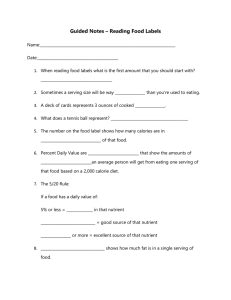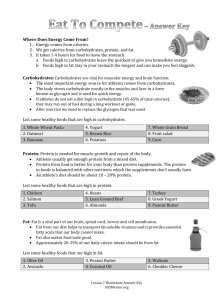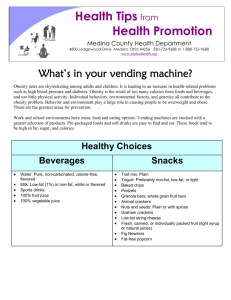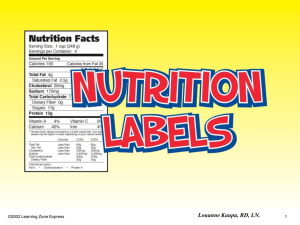Food Labels Decoded
advertisement
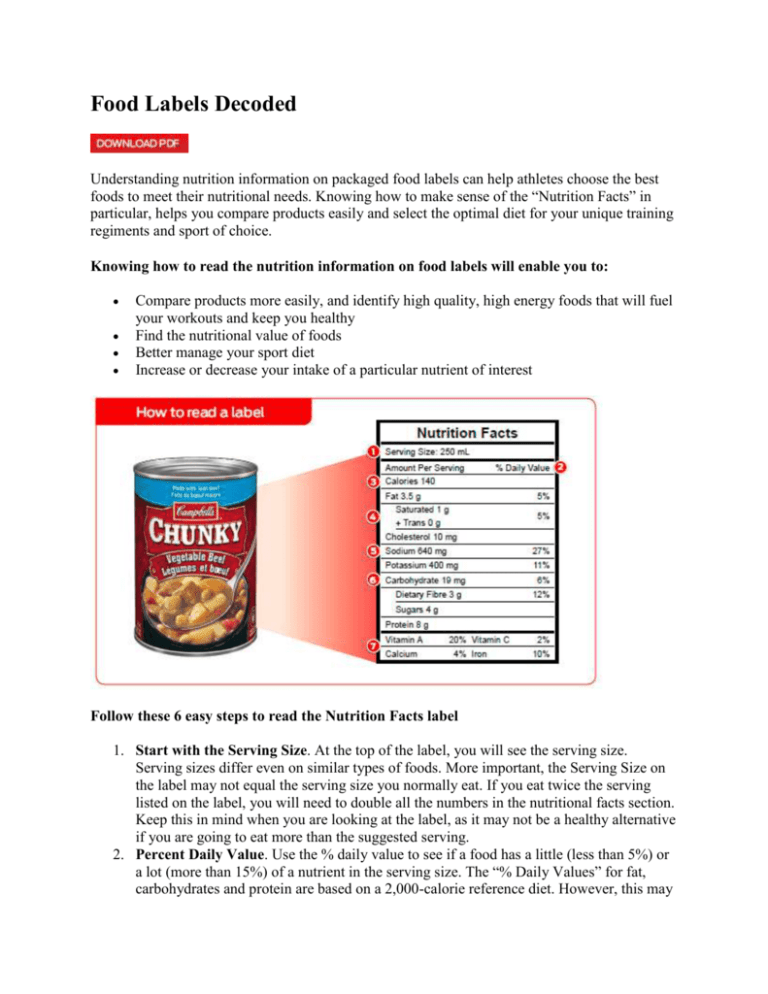
Food Labels Decoded Understanding nutrition information on packaged food labels can help athletes choose the best foods to meet their nutritional needs. Knowing how to make sense of the “Nutrition Facts” in particular, helps you compare products easily and select the optimal diet for your unique training regiments and sport of choice. Knowing how to read the nutrition information on food labels will enable you to: Compare products more easily, and identify high quality, high energy foods that will fuel your workouts and keep you healthy Find the nutritional value of foods Better manage your sport diet Increase or decrease your intake of a particular nutrient of interest Follow these 6 easy steps to read the Nutrition Facts label 1. Start with the Serving Size. At the top of the label, you will see the serving size. Serving sizes differ even on similar types of foods. More important, the Serving Size on the label may not equal the serving size you normally eat. If you eat twice the serving listed on the label, you will need to double all the numbers in the nutritional facts section. Keep this in mind when you are looking at the label, as it may not be a healthy alternative if you are going to eat more than the suggested serving. 2. Percent Daily Value. Use the % daily value to see if a food has a little (less than 5%) or a lot (more than 15%) of a nutrient in the serving size. The “% Daily Values” for fat, carbohydrates and protein are based on a 2,000-calorie reference diet. However, this may 3. 4. 5. 6. 7. be less than athletes require on a daily basis, so athletes should consider their individual nutritional needs for calories and nutrients when choosing foods. Review the Calories. This section on the label tells you the total number of calories in each serving of the food. For example, one serving of Campbell’s® Chunky® Vegetable Beef soup provides 140 calories. Carbohydrates, protein, and fat are three nutrients that provide our bodies with energy. Add up the “Total Fat”. Fat is an important nutrient for health and plays an essential role in the body, but it is important to remember that it is also very calorically dense. There are many different kinds of fats found in foods. The Total Fat value found on the Nutrition Facts includes monounsaturated and polyunsaturated fats (from plant sources, such as canola oil) as well as saturated and trans fats (from animal or vegetable sources). The type and amount of fat you eat are important. Some types of fat like saturated and trans fats, may increase your risk of developing heart disease and should be limited. Polyunsaturated and monounsaturated fats should count for most of the total fat in your diet. Look at the Sodium Content. Sodium is a mineral naturally found in many foods and can also be added by using table salt. Canadian adults need about 1500 mg of sodium per day and should not consume more than 2300 mg/day (or about 1 tsp). However, most Canadians are getting more than is recommended. Some athletes who typically lose large amounts of sweat and are at risk of hyponatremia should be aware of their individual needs. These athletes may need to consume sodium-rich foods before, during, and after their sustained activities. Check out the Carbohydrates. Carbohydrates include fibre, starch and sugar. Except for fibre, they provide energy to fuel your muscles and your brain during activity. Fibre, a non-digestible carbohydrate, is found in many foods and is important for daily and longterm health. Your diet should include carbohydrates as the foundation for each meal and when possible choose whole grains more often. Look at the Vitamins and Minerals. This section of the label helps you choose nutrient dense foods. The Nutrition Facts table is required to include information on calories and 13 ‘core’ nutrients including Vitamins A and C and minerals calcium and iron. There may be other vitamins and minerals nutrients in foods that may not be highlighted on the Nutritional Facts table. Note: There are also Nutrition Claims that appear on some food labels, for example, ‘low sodium’, ‘low fat’, ‘source of fibre’, etc. For more information about these claims check out http://bit.ly/IaHRD2 Finally, don’t forget to look at the ingredient list on the label. The list of ingredients is mandatory. All of the ingredients for a food are listed in descending order by weight. The list of ingredients is also a source of information for people who want to avoid certain ingredients like allergens or verify the presence of an ingredient in a food. go snac_results

